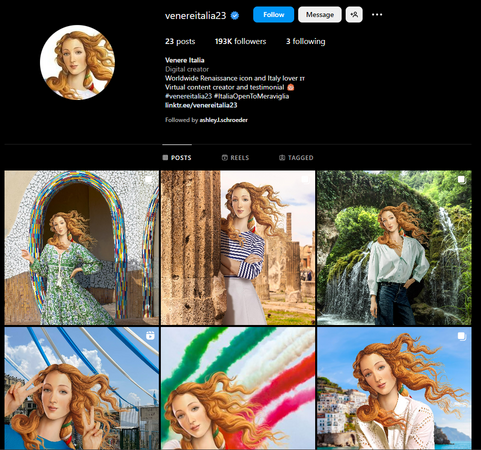AI has dominated the news for this first half of 2023 and using new artificial intelligence tools to help create ads has been all the buzz lately. So much so that NPR recently published an article and released a related podcast episode on how to recognize AI-generated images. The travel marketing space has been no different; AI has begun its integration with travel—including providing recommendations, booking, forecasting, creating itineraries, and now advertisements. Case in point, an AdAge article published in March explored how Lithuania Travel deployed the generative AI software Midjourney to make tourism ads for one of their campaigns.
With all the hubbub around AI and advertising, Destination Analysts decided to bring together a panel of travelers to react to AI-generated travel ads and see what we can learn about what travelers think about how AI is being used in travel marketing.
As marketers continue to experiment with AI, it’s imperative to keep our eyes on what really matters to travelers when it comes to advertising: unique destination experiences for real people.
Hot Takes on Visit Denmark’s AI-Authored Ad
Travelers were asked to view a campaign from Visit Denmark that used deepfake technology to bring famous works of art to life and employed a script written by ChatGPT.
All in all, this AI ad was well-received for the clever conceit of having highly recognizable works or art like the Mona Lisa speak directly to the viewer, but the animation of the deepfakes was slightly underwhelming to travelers. One person noted, “There’s work to be done to make the animations more fluid,” while another observed that some of the animations worked well but, for instance, the Statue of Liberty’s mouth did not move as well. A more seamless animation would have drawn viewers into the ad without distracting them with clunky visuals.
On the other hand, the script – combined with the famous artworks – was confusing for American travelers. While it was largely understood that most of these pieces are not located in Denmark, travelers were at a loss to comprehend why an advertisement about Denmark would spend so much of its run-time focused on artworks that are not actually in Denmark (with the exception of the statue of Hans Christian Andersen). The result was a highly mixed message; travelers wondered if the ad was about Denmark or about traveling the world. Rather than a clever advertisement showing famous, non-Danish pieces of art, travelers would prefer to see featured landmarks, attractions, or pieces of art specific to Denmark. As one traveler put it, focusing on interesting things to do and see in Denmark would have piqued their interest to visit the country more than fun, talking paintings. Playing with AI is fun and novel at the moment, but ultimately travelers want to know what they can experience in a destination that is unique and sets it apart from anywhere else.
Botticelli’s Venus Becomes a Virtual Influencer
Italy’s tourism ministry launched a campaign called “Open to Wonder” that features Botticelli’s Venus (of The Birth of Venus fame) as a modern-day virtual influencer, content creator, and tourism ambassador for Italy (Fig. 1). Throughout the campaign on Instagram, Venus is dressed in today’s designer clothing, taking selfies in St. Mark’s square, riding a bicycle in front of the Colosseum, and eating pizza on the shores of Lake Como.
Figure 1 and 2: Botticelli’s Venus as a virtual influencer for Italy
As part of the exercise, panelists viewed an Instagram reel created for the campaign, in which Venus showcases Italy as a travel destination.
Overwhelmingly, travelers said they would have preferred to see a real person rather than an AI person. The AI Venus influencer was described as “completely unrelatable” and “out of place.” One traveler noted that it was odd to see just a cutout of the painting, with no animation of the hair or facial expressions. Another argued that, even with more animation, the impact would have been minimal – without a living, breathing human to relate to, the ad garnered no additional interest in visiting Italy.
And travelers don’t just want any real person, but a lesser-known person – no celebrities, in other words. When it comes to sharing a travel destination, nothing beats someone real and relatable talking about their favorite places. Even a popular Italian TikTok-er or Instagram influencer would have been considered more appealing, and travelers expressed a keen interest in being able to see an actual human walking the streets and going into restaurants. As several travelers observed, it is always better with a real person.
The Future of AI in Travel Marketing
We are still in the early days of AI in advertising, but with major film studios like Marvel using AI to generate opening credits, and the sustained buzz around AI in the media this year, AI is here to stay and will have very real impacts on how travel marketing is done. With creative testing among travelers, travel marketers can continue to home in on best practices for employing AI and discover what works for their brand among their target audience. Even as marketers spark new creative ideas in how to wield AI in the most eye-catching (but relevant) ways possible, it’s imperative to keep our eyes on what really matters to travelers when it comes to advertising –unique destination experiences for real people.
For further opportunities for creative testing, please reach out to our research team at info@destinationanalysts.com to learn how we can best partner with you.
Learn more about the latest trends during our monthly livestream.
Have a travel-related question idea or topic you would like to suggest we study? Let us know!
We can help you with the insights your tourism strategy needs, from audience analysis to brand health to economic impact. Please check out our full set of market research and consulting services here.



